STRUCTURE OF THE EARTH'S LITHOSPHERE
 In the image to the right we see a small portion of the earth's outer layers enlarged to show more detail (click picture for a larger version).
In the image to the right we see a small portion of the earth's outer layers enlarged to show more detail (click picture for a larger version).The drawing begins at the earth's surface (sea level) and descends about 150 kilometers down. There are several layers shown, color coded brown and black, green, and reddish.
The outermost brown and black layer, above the Moho (boundary between crust and mantle) is the crust. It has two major divisions: ocean basins (black layer) composed of mafic rocks (or see primer) like basalt and gabbro, and continents (brown layer) composed of felsic rocks (or see primer) such as granite. the crust extends to a depth of about 70 km, and represents less than 0.1% of the earth's total volume.
The continent in the upper center is a continental craton. A craton is a stable continent eroded down to just above sea level. Because continental cratons are composed of light weight rock such as granite they are like a boat resting in water, neither rising nor sinking on their own. They are said to be in isostatic equilibrium. Conversely, mountains of any kind must be held up by something, like heat or a root zone, or they will sink right back into the earth.
The Moho lower boundary of the crust marks the transition from the granite and basalt of the crust to the ultramafic rocks (or see igneous primer) of the mantle below.
The outer layers of the earth are subdivided on two totally different criteria, composition and behavior, and these overlap in non-obvious ways, often leading to confusion if we don't pay attention.
Compositionally, the Moho separates the crust, composed of relatively light weight felsic and mafic rocks, from the ultramafic rocks of the mantle. The felsic and mafic rocks are analagous to the light weight slag that floated to the surface during the earth's molten stage.
Behaviorally, the outer earth layers are divided into the lithosphere and asthenosphere (see right side of enlarged drawing). The lithosphere is the cold, rigid outer layers, and is composed of the crust and the outermost portion of the mantle.
The underlying asthenosphere is all ultramafic mantle, but it is hot and plastic. The convection cells operate within the asthenosphere.
OK, if we have these divisions straight, we can now begin to define a tectonic plate. A tectonic plate is composed of the cold, rigid lithosphere that is floating (very slowly!) on the underlying asthenosphere.
This defines what a plate is vertically, but does not explore the boundaries among plates, which we do next.
Go On To: